supply structure
Generally speaking, wholesale power markets are comprised of large central station generating plants, usually remote from population centers, together with high voltage transmission lines needed to get power from those plants closer to where it is used. The retail portion of electric supply includes parts of the system closer to end-users, that are needed to transform the power into usable voltages, distribute it along or under local streets and highways, and connect it to buildings and facilities where customers use it.
Apart from these physical components of the system, it’s important to understand something about the institutional and regulatory arrangements that govern California’s electricity supply. These arrangements were well established and relatively static for much of the 20th century. But in the 1990’s, they changed dramatically in California and many other states with the advent of electricity ‘deregulation’ (more accurately called ‘restructuring’, since much of the electric industry remains heavily regulated by both federal and state agencies).
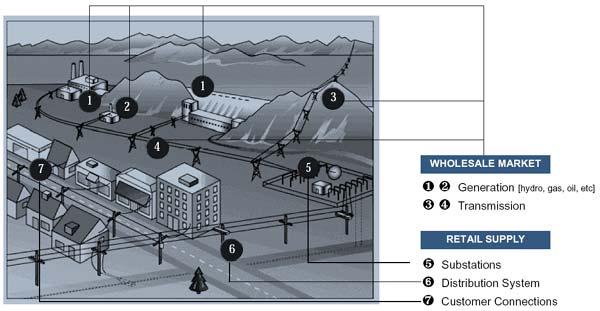 Figure 1 above illustrates the basic physical components of California's electric supply system.gy
Figure 1 above illustrates the basic physical components of California's electric supply system.gy
Beginning in 1992, the U.S. Congress and the Federal Ener Regulatory Commission (‘FERC’, which regulates wholesale sales and interstate transmission of electricity) began moving toward competitive electricity markets by requiring electric utilities to provide ‘open access’ to their transmission systems for generators and others wishing to sell power. Within a few years, California and other state legislatures began to extend competitive principles beyond wholesale power markets to the retail portions of the system which the states regulate.
In 1996, California’s legislature enacted our state’s electricity restructuring legislation. Known as Assembly Bill (AB) 1890, its purpose was to advance competition in the generation component of the system, and to extend ‘open access’requirements from the transmission system to the distribution systems of California’s investor-owned utilities (principally PG&E, Southern California Edison. and San Diego Gas & Electric). As part of the transition to a competitive market, AB 1890 also required these utilities to freeze the rates charged to residential and small commercial customers for a period of time.
| before restructuring | since restructuring |
| Electric Utilities owned and controlled generation, transmission and distribution. | Electric Utilities were required to sell off most of their generation, and to allow competing generators access to their distribution systems. |
| Rates were regulated by California PUC, and were tied to utility costs. | The generation component of rates is no longer regulated, but is set by supply and demand in “competitive” generation markets. |
| Utilities were “monopoly” suppliers, with exclusive territories sanctioned by the State. | Customers were empowered to choose among competing generation suppliers. |
Table 1 [above] highlights three important characteristics of California's electric supply structure before AB 1890, and contrasts them with the situation since then.
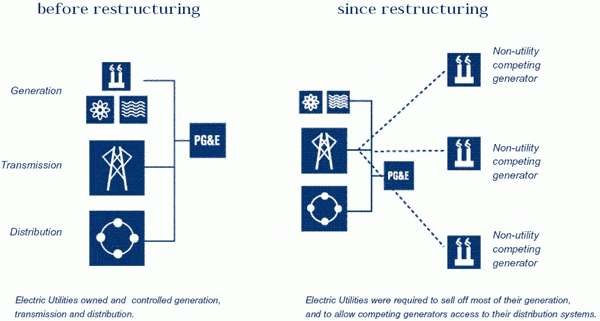
Figure 2 illustrates the ownership and relation of generation and other system components before and after restructuring.
Components of Restructuring
generation divestiture and market creation. Because PG&E and other investor-owned utilities historically had owned their own generation and supplied it to customers through their own transmission and distribution systems, competitive markets for generation output generally did not exist. H o w e v e r, A B 1890's requirement that utilities divest their generation assets and open their systems to competitively-procured power, required the creation of such markets.
AB 1890 created them by launching two new institutions, the Power Exchange (PX) and the Independent System Operator (ISO). The PX was established to provide a competitive auction. Generators (including some retained by the utilities) competed to sell power into the PX at unregulated prices set by the auction. Utilities purchased from the PX – also at unregulated market prices – most of the power they delivered to customers (see Figure 3). The ISO was created to ensure fair access to the wires and the customers they served, by operating (though not owning) the investor-owned utilities’ statewide transmission system.
By early 2001, California’s market crisis and the rate freeze that prevented utilities’ from raising rates to pay skyrocketing PX power prices, caused the PX to fail. It ceased operating, and legislation was passed that authorized the California Department of Water Resources (DWR) to purchase wholesale power and sell it to retail customers and publicly-owned utilities at cost. The legislation also permitted DWR to contract with investor-owned utilities for delivery to their customers, and for billing and collection services the utilities now perform as agents for DWR. DWR’s power purchases and related activities are funded from various State sources, including the General Fund and a planned multi-billion dollar bond issue.
rates for generation. As indicated in Table 1, before restructuring, utility rates to customers were fully regulated by the California Public Utilities Commission (CPUC), based on the utilities’ costs to produce and deliver power. Since restructuring, the generation component of electric rates (as distinct from the transmission and distribution components) has not been regulated, but has been allowed to fluctuate with supply and demand reflected in the competitive market just described.
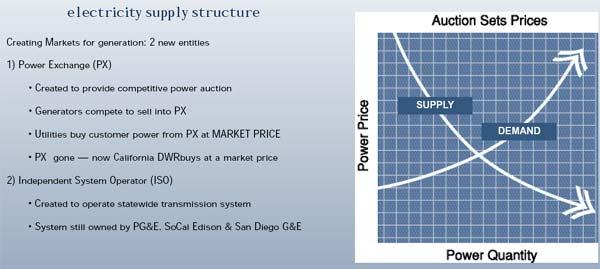
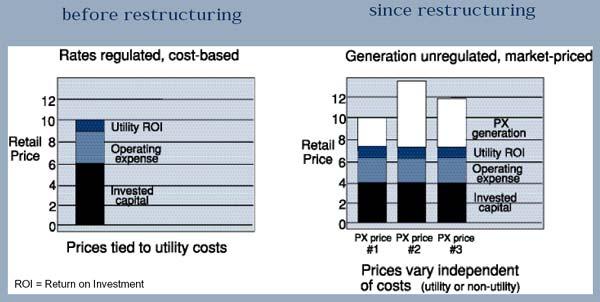
Fluctuating generation prices have accounted for most of the price increases and volatility Californians have experienced during the past year, as shown in Figure 4 above (using illustrative, not actual prices).
customer choice and direct access. The third important change highlighted in Table 1 was that the monopoly the state had historically conferred on California’s investor-owned utilities (through exclusive service territories and barriers to competitive entry) was ended as to generation, and weakened as to transmission and distribution. AB 1890 did this by giving customers ‘direct access’ to nonutility generators through the utilities’ wires, and the freedom to choose a generation supplier other than their serving utility. At the same time, the law designated the serving utilities as ‘default providers’ for customers who did not choose to switch to competing providers. As it has turned out, these comprise the great majority of customers (see Figure 5 below).
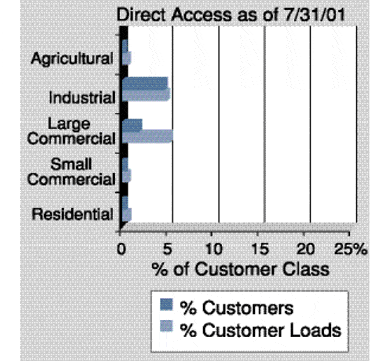 restructuring impacts. The recent impacts of California's electricity restructuring are now known only too well: much higher and more volatile costs to consumers, lower service quality and blackouts, the bankruptcy of PG&E and possibly of Southern California Edison; and the State's entry into wholesale power markets, incurrence of massive debt, and possible purchase of the utilities' transmission systems. All of these problems remain to be solved on some long-term basis. In the meantime, Californians' f r u s t r a t i o n with the state's energy situation has led to a renewed interest in other options to supplement or supplant the current system. Prominent among these are options for publicly-owned and/or -controlled power systems, including the MUD and MWPA proposals slated to appear on the November 6 ballot. The next section briefly reviews the general characteristics of public versus private power, and then describes where these two structures fall within a range of options available to California municipalities to exercise increased control over electricity supplies.
restructuring impacts. The recent impacts of California's electricity restructuring are now known only too well: much higher and more volatile costs to consumers, lower service quality and blackouts, the bankruptcy of PG&E and possibly of Southern California Edison; and the State's entry into wholesale power markets, incurrence of massive debt, and possible purchase of the utilities' transmission systems. All of these problems remain to be solved on some long-term basis. In the meantime, Californians' f r u s t r a t i o n with the state's energy situation has led to a renewed interest in other options to supplement or supplant the current system. Prominent among these are options for publicly-owned and/or -controlled power systems, including the MUD and MWPA proposals slated to appear on the November 6 ballot. The next section briefly reviews the general characteristics of public versus private power, and then describes where these two structures fall within a range of options available to California municipalities to exercise increased control over electricity supplies.
Institutional Structure
a. general characteristics of public versus private power
The term ‘public utility’ often causes confusion, for it refers not to the ownership of a utility, but to the nature and scope of the service it offers. California and most other states actually define a ‘public utility’ as a private, typically investor-owned, entity that provides any of certain specified commodities or services (e.g., electricity, gas, heat, water, telecommunications, etc.) ‘to the public’ or ‘for public use’. This means it sells to anyone who applies for service within a defined geographic area, usually under a standard tariff, as distinct from sales to selected individuals or businesses under individually negotiated contracts. Private persons or corporations who meet these tests are defined as ‘public utilities’ subject to regulation by state public utility commissions. California’s largest investor-owned public utilities are PG&E, Southern California Edison, and San Diego Gas & Electric Company.
At the same time, California and other states have separate enabling legislation that allows municipalities and other public entities to establish, own and control utilities to provide commodities and services similar to those offered by private investor-owned utilities. These are generally self-governing entities responsible to the public that elected their members, or to public officials who appointed them. As described in Section C (see page 22), public power entities can take a variety of forms, including city-owned utilities (like San Francisco’s Public Utilities Commission, the Los Angeles Department of Water & Power, the City of Palo Alto Utilities Department, Alameda Power & Telecom, or Santa Clara’s Silicon Valley Power) and independent municipal utility districts (such as the Sacramento Municipal Utility District or the Lassen County Municipal Utility District).
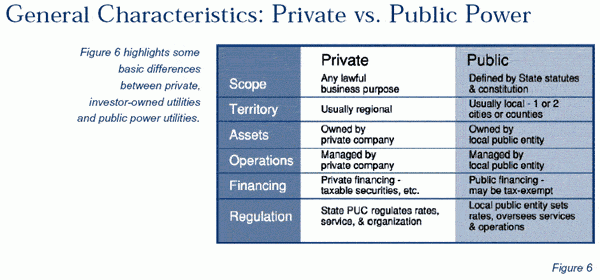
b. programmatic options for public power
Not all public power initiatives require the creation of new institutional structures such as a MUD or the MWPA. Even within their existing structures, departments of San Francisco city government can sponsor, support or undertake some important kinds of energy activities. Examples include:
• Load management, energy efficiency and conservation in municipal facilities, and/or programs to support those activities by City residents and businesses.
• Electricity procurements, perhaps including municipal aggregation that would combine San Francisco customer loads in order to negotiate better prices and terms from generation suppliers. (As provided by Assembly Bill x2 9, passed by the California Legislature in September 2001.)
• ‘Distributed’ generation in the form of small, local generation facilities designed to serve onsite or nearby electric and thermal loads; these might be owned by the City or third parties, and could include renewable resources such as solar or wind, as well as emerging fuel cell technologies that will provide clean, efficient power from natural gas, digester or landfill gas, or other renewables.
In addition to these options available to cities in general, on August 27, 2001, the San Francisco Board of Supervisors unanimously adopted Resolution 723-01:
“urging the Mayor to create an Office of Public Power within the Public Utilities commission charged with the responsibility of securing expeditiously reliable and affordable electric power for San Francisco residents and businesses, including City Departments, and urging the State of California to cooperate with the San Francisco Public Utilities Commission by facilitating the purchase of low cost electricity.”
c. structural options for public power
Apart from these kinds of programmatic options, public power can and does take various structural forms. California law establishes a number of distinct institutional vehicles for public planning and implementation (including ownership, financing and operation) of electric utility systems. As indicated in figure 7, these include municipal utilities, Community Energy Authorities, Joint Powers Agencies, Municipal Utility Districts, and other types of special districts. All of these vehicles offer public participation in the development, ownership and operation of utility systems. However, they vary in their independence from the communities they serve, the ways they are formed and governed, and the specific legal authorities they possess. For more detail on CEAs, JPAs, and Special Districts, see Appendix D.

Figure 7: Public power can and does take various structural forms, distinguished partly by their relations to existing local governments. See Appendix D for a more detailed discussion of the types of public power entities allowed under California law.
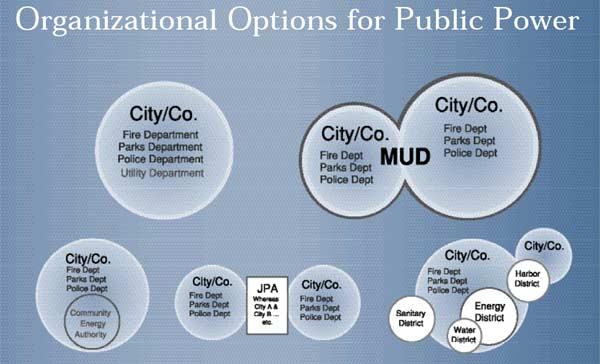
Figure 8 graphically illustrates the relationship of each type of public power entity to existing local government entities.
municipal utility. California’s Constitution (Article 11, Section 9) allows municipalities to establish, purchase & operate public works to furnish their inhabitants with power, light, heat, water, transportation or communications. A ‘municipal utility’ (not a municipal utility district) generally refers to a city or county department responsible for providing one or more of these services, sometimes only to municipallyowned facilities but often to residents and businesses within city or county limits as well. Among other things, California statutes (e.g., Public Utilities Code §§10001 et seq.) permit such entities (either within or beyond city or county boundaries) to:
• Acquire (through condemnation or otherwise), construct, own, operate, or lease facilities to provide utility services;
• Acquire (through condemnation or otherwise), own, control, sell, or exchange property and other rights;
• Build, operate and maintain wires and related equipment; and
• Sell or distribute excess energy.
An example of a municipal utility would be the existing San Francisco (not California) Public Utilities Commission. It is a City department that operates San Francisco’s Hetch Hetchy water and power system to provide electricity to municipal facilities such as City Hall, the municipal railway, and the airport. As discussed later, the proposed MWPA would be a variant of this kind of municipal utility (distinguished principally by district elections of board members, and expansion of service to residents and businesses). Other Bay Area cities with municipal utilities include Alameda, Palo Alto and Santa Clara.
municipal utility district. MUDs are one of many distinct types of special district which can be organized and operated under their own specific enabling legislation, in this case Division 6 of the California Public Utilities Code. Unlike municipal utilities or CEA’s, MUDs must be formed by two or more public agencies (which include cities and several types of districts). Their formation is initiated by resolution of the legislative bodies of half or more of the agencies, or by petition presented to the board of supervisors of the county containing the largest number of voters in the proposed district. The supervisors then divide the proposed district into five wards of approximately equal numbers of voters and call an election. They must canvass the election returns of each public agency separately, and create the district to include only the public agencies in which a majority of those voting voted for it (so long as the voters in those areas comprise at least 2/3 of the voters in the district as originally proposed).
Once formed, new MUDs are governed by a five-member board, with one director from each ward, elected at large. The MUD board determines policy, supervises and regulates MUD-owned and -operated utilities (electric and other), fixes rates and charges, and makes and enforces district rules, contracts and practices. Among other things, MUDs are empowered to:
• Acquire and own property (including utility property) by eminent domain or condemnation;
• Build, own, operate, control and use facilities to supply power, light, heat, water, transportation, communications, garbage and sewage service;
• Borrow money, issue bonds and levy taxes;
• Build and operate facilities to supply electricity and heat;
• Act to reduce wasteful, uneconomic or unnecessary energy use;
• Sell surplus energy outside the district; and
• Overrule some local agency decisions regarding the location and construction of transmission or distribution lines.
California thus provides a number of vehicles for public ownership, financing and operation of electric utility activities. Each one provides for public participation in electricity supply. However, methods of formation, structures of governance, and specific powers vary in ways that can affect their relation to the communities they serve, as summarized in Table 2 below.
To make an informed decision among available public power entities requires careful analysis of specific authorizing legislation relative to the community’s goals, and a basic understanding of utility regulatory, financial and operational considerations.
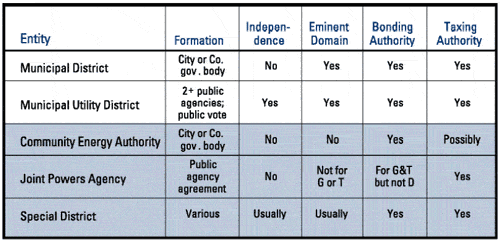
Table 2
California’s Public Power Experience
This paper does not attempt a detailed historical comparison of public versus private power in California or elsewhere. However, it is worth noting that in the aggregate, average residential and commercial rates are somewhat lower, and average industrial rates somewhat higher, for public power than for private power customers in California, as illustrated by the following chart (compiled by the American Public Power Association using 1999 data).
California presently has something over 30 public power entities. Most are city-owned municipal utilities, as defined earlier. A number are independent MUDs, but only two of those operate as electric utilities: the Sacramento Municipal Utility district (SMUD) and the Lassen Municipal Utility District (LMUD). Salient facts about each are shown in Figure 10.
SMUD is comparable in some ways to the proposed San Francisco/Brisbane MUD, so it may be helpful to understand where it gets the power that it supplies to its customers. SMUD’s generation from all sources peaks at about 2,700 MW, dividedmalmost equally between power purchased from others under long-term contracts, and power produced by S M U D ’s own generating plants. Of the power produced by SMUD’s own plants, over 57% comes from hydroelectric resources, about 42% from thermal (typically gas-fired) resources, and about 1% from solar photovoltaics and wind resources combined.
The hydroelectric resources that constitute most of SMUD’s generation include plants ranging from .4 to 224 megawatts (MW). These resources almost certainly could not be duplicated at this scale today because of environmental concerns over large hydro development. Many of the thermal resources that comprise most of the rest of SMUD’s generation utilize cogeneration (i.e., combined heat and powerproduction) for more efficient fuel use.
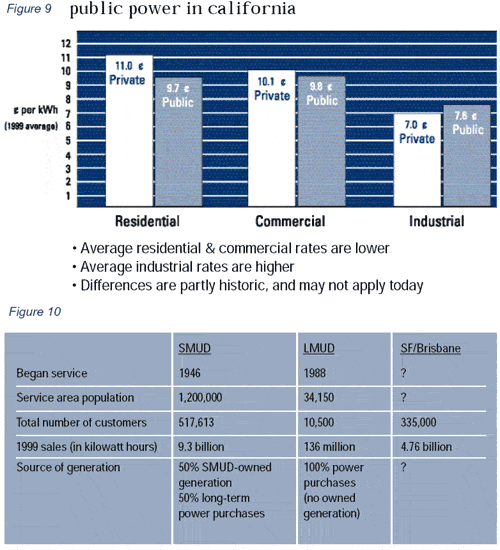
SMUD is widely considered to be a progressive and well-run utility, with a strong commitment to efficiency and renewable resources. Its purchased power includes some production from geothermal power plants, and its own generation also includes renewables. Solar and wind together comprise only about 1% of SMUD's generation now, but this can be expected to increase as these and other clean ‘distributed’ energy technologies reduce their costs, improve their performance, and enter commercial markets on a larger scale.
Both SMUD and LMUD historically have offered lower rates than PG&E. Both SMUD and LMUD have increased their rates this year in response to California’s energy market crisis, SMUD by about 19% for residential and up to 30% for commercial customers, and LMUD about 80% for residents and 77% for commercial customers. Because they rely on the statewide transmission system to deliver some or all of their power, both remain subject to any blackouts called by the ISO (as does any utility, public or private, which does not generate and transport all of its power on its own system).
mud proposal
a. background
The ballot language for Measure I consists of a single sentence: “Shall the San Francisco-Brisbane Municipal Utility District be created and established?”
This ballot initiative resulted from a petition circulated in June 2000, and signed by voters equalling at least 10% of the total vote cast in the preceding election, as provided in California’s Municipal Utility District Art (Public Utilities Code §§11501 et seq.).
The proposal is to create a Municipal Utility District whose physical boundaries would include the City and County of San Francisco and the City of Brisbane. Under the Municipal Utility District Act, The District would not function as part of, or be responsible to, either San Francisco or Brisbane city government: it would be a separate and independent legal entity whose structure, procedures, and powers are governed by State, not local law, and whose 5-member governing body would be elected at large from 5 wards which would comprise the District.
b. what the mud would do
Although the ballot language is sparse, MUD proponents have described in various public forums their intention to create a public power agency which would become the electric service provider for San Francisco and Brisbane. To achieve this, they state that the MUD would exercise its power of eminent domain to condemn, take over and operate PG&E’s existing transmission, distribution and/or generation facilities serving San Francisco and Brisbane customers.
The proponents have also said that they expect the MUD to review other types of utilities operating within the district for possible future takeovers, since state law authorizes MUDs to provide not only electricity and lighting, but also transportation, communications, heat, water, garbage and sewage service.
Although some of these proponents are now seeking election to the MUD’s board of directors, it would ultimately be that elected board (which might or might not include the current proponents) that would establish MUD policy and oversee its implementation. This also means, for example, that the proponents’ assurances that there will be no fossil or nuclear power plants in Brisbane, and that any new generation facilities or condemnation of non-PG&E property there would require Brisbane voter approval, would not bind an elected MUD board.
c. how the mud would be governed
California law provides that MUDs generally are comprised of 5 wards, each with a roughly equal number of voters. Those wards have been identified, and a map is attached as Appendix B. The law further provides that MUDs are to be governed by a 5-member board, with one director elected from each ward. Board elections are ‘at large’rather than by district, meaning that all voters throughout the district may vote for directors representing all wards. The list of candidates that the San Francisco Elections Department reports have qualified to appear on the ballot for MUD director positions, with their occupations and contact information, is attached as Appendix C.
Once elected, the MUD board of directors acts as the District’s legislative body, empowered to:
• Determine MUD policy
• Supervise and regulate all MUD-owned utilities
• Fix rates, charges and classifications for each MUD-owned utility
• Appoint a general manager and other district officers
• Make and enforce rules, contracts, practices and schedules for MUD services.
d. would the mud yield lower electric rates?
The MUD proposal placed on the November 6 ballot did not proceed from a feasibility study or other comprehensive legal, economic or financial analysis that has been made public. As of this writing in October 2001, no such analysis has been published by the MUD proponents to our knowledge. The San Francisco LAFCO did recently hire a consultant to consider some of the issues raised by a MUD. However, the LAFCO’s Director found preliminary drafts incomplete and lacking in objectivity and the consultant was terminated on September 28. It is now unclear whether the report will be completed or its results made public.
In 1996, the City and County of San Francisco did sponsor a preliminary feasibility study of municipalization. The study’s objectives were to determine whether or not the City and its residents were likely to benefit from municipalization and by how much, and whether any potential benefits would likely outweigh the costs and risks sufficiently to justify investment in a full feasibility study. The study produced a detailed 165-page report (exclusive of appendices) in December 1996 (Feasibility Study of Electric System Municipalization for San Francisco Public Utilities Commission, December 31, 1996, submitted by Economic & Technical Analysis Group.) Its key conclusions were that:
• Any electric rate savings from municipalization most likely would be less than 5% compared to PG&E’s rates;
• No evidence supported a change of more than 10% in either direction, and that a change of that much was “highly unlikely”;
• The outcome of any rate comparison was dominated by a single factor: the cost of acquiring PG&E’s local electric distribution system (the estimated value of which the report concluded could range from about $300 million to well over $1 billion, with a base case of about $800 million); and
• Any real economic savings would be due almost entirely to municipal avoidance of state and federal income taxes, which privately-owned businesses like PG&E must pay.
While the MUD itself would benefit from not paying income or other taxes that investor-owned utilities pay, the City, State and federal governments would lose the revenues those taxes contribute. PG&E has been one of San Francisco’s largest taxpayers, contributing some $22 million annually to the City and County’s budget. If a MUD were to supplant PG&E’s San Francisco activities, either public expenditures would need to decline by that amount, or public revenues would need to increase through additional taxes imposed on others, or through some other revenue mechanism.
It is worth noting that the City’s 1996 municipalization study was done very early in California’s electricity restructuring process (before competitive electricity markets began operating) so some of its assumptions would need to be revisited to reflect today’s market conditions. Also, the municipalization study did not specifically address a MUD as distinct from a City-owned utility, and did not consider the impacts of including Brisbane in any municipalization effort. If anything, however, its key conclusions probably would be more favorable for a City-owned utility than for a MUD since, as discussed next, a MUD would have no entitlement to Hetch Hetchy hydropower, and likely would incur some startup costs that a City department might avoid.
e. where would a mud get its power?
In public forums, MUD proponents have stated that a MUD could provide lower-cost power than San Francisco and Brisbane citizens now receive by utilizing inexpensive, environmentally sound hydroelectric power from the Hetch Hetchy system.
The Hetch Hetchy water & power system consists of reservoirs, dams, hydroelectric plants, aqueducts, pipelines and transmission facilities managed and operated by the City of San Francisco’s Public Utilities Commission. The system provides drinking water for the City and several counties, as well as hydroelectric power for the City’s municipal uses (e.g., City offices, Muni Railway, International Airport, etc.), and for sale to irrigation districts when there is excess over municipal needs.
The heart of the Hetch Hetchy system is located on public lands, including Yosemite National Park, Stanislaus National Forest, and parts of Tuolomne, Stanislaus, San Joaquin and Alameda Counties. These lands are owned and controlled by the federal government and subject to federal law. San Francisco has been able to develop and use Hetch Hetchy water and power because the U.S. Congress specifically granted it rights to do so in legislation known as the Raker Act of 1913.
Section 8 of the Raker Act expressly defines the ‘grantee’ of these rights as:
“…the city and county of San Francisco and such other municipalities or water district or water districts as may, with the consent of the city and county of San Francisco or in accordance with the laws of the State of California, hereafter participate in or succeed to the beneficial rights and privileges granted by this act.”
The proposed MUD would be a separate and distinct legal entity, not part of the City and County of San Francisco, not named as ‘grantee’of any Raker Act rights, and therefore not legally entitled to Hetch Hetchy power without the City and County’s consent, or possibly some state legislative authorization. At this point, it is unknown whether either would be forthcoming, or what conditions might be attached if they were.
Apart from this question of legal entitlement, it is important to understand how much power Hetch Hetchy actually produces. Hydroelectric power depends ultimately on the availability of water to power turbines. Like any hydroelectric resource, Hetch Hetchy’s power output varies annually and seasonally with precipitation and other weather conditions. If its power plants were to operate at full capacity, their maximum production at a given moment would be about 380 megawatts (380,000 kilowatts). Most of the year the plants operate at considerably less than their full capacity, and their actual production over the course of a year, measured in “kilowatt-hours” (kWh), varies considerably.
The San Francisco Public Utilities Commission reports that Hetch Hetchy production averages about 1.6 billion kWh annually (see http://www.ci.sf.ca.us/puc/html/hetchy.htm for additional Hetch Hetchy information.) This compares to the electricity requirements of San Francisco and Brisbane customers served by PG&E, roughly as follows (1999 figures):
| Hetch Hetchy Output | SF / Brisbane Requirements | % of Requirements Hetch Hetchy Could Meet | |
| Capacity (instantaneous) | 380 MW | 900-1000 MW | 38-42% |
| Production (over time) | 1.6 billion kWh/year | 4.76 billion kWh/year | 33.6% |
These figures indicate that if Hetch Hetchy power were to become available to the MUD, it could meet about 40% of San Francisco and Brisbane’s recent peak demand, and about 1/3 of recent annual customer requirements in the two cities. The remaining 60% of peak demand and 2/3 of annual electricity requirements (even without any demand growth) would need to be met from other sources.
Those sources could include (1) other generation the MUD would acquire or build, (2) power the MUD would purchase from the same electricity markets (described in Section II) where California’s investorowned utilities have had to acquire power for their customers, and/or (3) bilateral contracts with other generators also operating in those markets (including both private companies like Enron, Reliant, Dynegy or Mirant, and publicly-owned generators like SMUD or the Los Angeles Department of Water & Power).
The first option, acquiring or building generation facilities, would incur substantial costs beyond the costs of acquiring PG&E’s San Francisco distribution system (which the 1996 municipalization report estimated at $300 million to $1 billion or more). To this point, we are not aware that the MUD proponents have analyzed, estimated, or made public what those additional costs might be.
As to the second option – purchases from competitive electricity markets dominated by large energy trading firms like Enron – it is not apparent what special experience, expertise, resources, sophistication or other advantages the MUD could bring to reduce its purchased power costs below those available to PG&E or other California market participants.
The third option – purchasing power directly from others, including other public power entities – would be subject to the same market forces, since those entities will continue to operate in competitive markets. Purchases from publicly-owned generators unfortunately offer no panacea. On July 11, 2001 the San Francisco Chronicle reported that first-quarter sales by publicly-owned entities to the PX and DWR averaged nearly 40% higher than those charged by private generators – benefiting their own citizens at the expense of other Californians whose utilities were required to buy from those markets. And on September 10, the Los Angeles Times reported that a Price Waterhouse audit of the Los Angeles Department of Water & Power (a municipal utility) for the 13 months beginning in May, 2000 revealed that its electricity sales to power-short areas of the state yielded average profits of 56%, with overhead charges three times the amount that federal regulators consider reasonable.
f. when would mud service begin, and how would the system be maintained during any transition?
Voter approval of the MUD in November would be the first step in what is likely to be a lengthy process before any MUD services actually commence.
To begin with, California Government Code Sections 56129-56130 provide that if part of the service area of a public utility such as PG&E that furnishes gas or electric services, becomes part of the territory of a district authorized to provide those services, then the district shall not provide those services within the territory unless a majority of voters within the territory approve a ballot question which designates, among other things, that gas or electric service is to be furnished. The law requires that this question be submitted as a separate proposition.
The language placed on the November 6 ballot reads in its entirety: “Shall the San Francisco-Brisbane Municipal Utility District be created and established?” It does not designate the kind of service to be furnished, or state that the MUD will furnish gas or electric service. Whether or not the law requires such specificity in order to create a MUD, it clearly requires it before the MUD can actually furnish service in its territory. This means that if voters approve the November 6 ballot initiative, there will need to be a separate election to present the question of what kind(s) of service the MUD will provide, and specifically whether it will furnish gas or electric service.
Although MUD directors are to be elected at the same November 6 election, it will take time for a newlycreated district to plan and raise financing for its activities; hire qualified and experienced staff; acquire generation, transmission and distribution facilities; establish power purchase capabilities; set up system operations and maintenance functions; and design and implement customer service and billing systems.
How much time this would take is difficult to predict, but the history California’s two existing electric MUDs – Sacramento and Lassen – may offer some guidance. They are very different from each other in scope and size, and have very different histories. The Lassen MUD (LMUD) is also very different from the proposed San Francisco/Brisbane MUD: it serves only about 3% of the number of customers that the proposed MUD would serve, and less than 3% of the annual electric demand. It was formed in 1986 and began operating in 1988, when it purchased the local system then owned by CP National. As described by LMUD staff, CP National was then in the process of selling many of its electric assets, and it sold its Lassen assets to the newly- formed district voluntarily, by mutual agreement with LMUD. LMUD did not exercise its eminent domain power, and the acquisition was completed without condemnation litigation.
The San Francisco/Brisbane MUD (SFBMUD) would be more comparable to Sacramento (SMUD) in size and scope. About 1.2 million people live in SMUD’s service territory, compared to about 800,000 in SFBMUD’s. SMUD serves about 518,000 customers, while SFBMUD would serve about 335,000 (based on PG&E’s current customer base.) SMUD’s annual electric sales approximate 9.3 billion kWh; SFBMUD’s would be about 4.8 billion (again based on PG&E’s service to the two cities.)
SMUD’s website (http://www.smud.org/info/history/50th/50th.html) offers the following summary of its own history:
“Although the voters created SMUD in 1923, the District could start operations only when it acquired funding and bought the distribution system from the [then] current owner, PG&E. …
“From 1923 to 1945, the “Sacramento Municipal Utility District” consisted of four employees … working to finance the District’s operations and to acquire the distribution system from PG&E.
“A series of bond sales in the 1930s accomplished the funding. But PG&E didn’t want to sell its distribution system for the price set by the Railroad Commission. Finally, SMUD was forced to take the old owner to court.
“In April, 1946, after 12 years of litigation, a California Superior Court judge ordered PG&E to transfer title of Sacramento’s electric distribution system to SMUD for $13 million. After 23 years of paperwork, SMUD was at last to become a working municipal utility — and it had only six months to get up and running.
“The four employees put out a call for experienced linemen, electricians, and officeworkers. By December, they would hire more than 400 people to operate the new utility. ”
Local MUD proponents have stated their intention that the new district would exercise its eminent domain power to take over PG&E’s San Francisco/Brisbane distribution system. There is no reason to believe that PG&E would acquiesce in the effort to take assets central to its system. On the contrary, it is all but certain that the MUD would need to pursue eminent domain litigation to condemn PG&E’s property for its own use. Such litigation would address a complex set of legal issues defined by the federal constitution, and by California’s own constitution and statutes. Under existing and proposed California statutes, these issues would include at least some combination of the following:
• Whether the public interest requires the takeover;
• Whether the takeover would be compatible with the greatest public good and the least private injury;
• What specific components of PG&E’s generation, distribution and/or transmission system would be acquired, and whether they are necessary for the MUD’s activities;
• Whether proposed legislation seeking to forestall these inquiries is constitutional;
• Whether there is an economic basis for any finding of ‘necessity’, based on findings as to the MUD’s projected costs, its ability to provide power, its financial condition, and the possible side effects of any takeover; and
• The dollar value of whatever generation, transmission, distribution or other property the MUD proposes to take from PG&E (preliminarily estimated by the City’s 1996 study at between $300 million and $1 billion and possibly substantially more).
Under California law many of these questions, including valuation, would be decided by a trial jury after months, or more likely years, of litigation. Whether that litigation would last for 12 years, as SMUD’s did, or for a shorter or longer period, no one can say. Litigation uncertainties would be compounded by PG&E’s pending bankruptcy litigation, and the Federal Bankruptcy Court’s responsibility to protect, preserve and ensure the value of PG&E’s assets for the benefit of its creditors. All that is certain in these circumstances is that the issues are difficult and complex, and will not be resolved quickly or cheaply.
Until they are, it is legitimate to ask how the possibility of condemnation and the uncertainty of protracted litigation will impact investment in, and maintenance of, the utility assets used to serve San Francisco and Brisbane. Unless PG&E can be assured of recovering its costs through future rates, it is difficult to see what will induce it to make the investments needed to maintain these facilities or improve them to keep up with the area’s demand growth. The state Public Utilities Commission would play an important role here, but at the very least would have a difficult task forcing investments and expenditures that the utility has no assurance of recovering.
MWPA Proposal
a. what is the charter amendment’s intent?
Section 3 of the proposed Charter Amendment would add a new Article VIIIB to the City Charter, section 8B.100 of which states that the article’s intent is: “to end Pacific Gas & Electric Company’s monopoly in San Francisco, to revoke Pacific Gas & Electric Company’s franchise, and to create a full-service public power system in the City to sell power directly to consumers...”
b. what would the charter amendment do?
The Amendment would eliminate the City’s existing Public Utilities Commission (SFPUC) as of May 1, 2002. It would establish a new City department known as the Municipal Water and Power Agency (“MWPA”) to assume the former SFPUC’s powers and responsibilities, including its oversight of the Hetch Hetchy Water and Power System, and to provide service directly to San Francisco residents and businesses. The Charter Amendment applies only to San Francisco’s charter. It does not directly affect Brisbane, although the MWPA’s activities could (particularly if it pursues condemnation of PG&E property).
c. what would the new mwpa do?
The new MWPA would be responsible to build, manage, supervise, maintain, extend, operate, use and control the City’s water, water pollution control, and energy supplies and utilities, wherever located. It would also have authority over supplies, utilities and property, including financial and other assets related to water, water pollution control and energy that the City later acquires.
mwpa goals and objectives
The proposed Charter Amendment directs the MWPA to adopt goals and objectives that include:
• Stable, affordable rates
• Robust, reliable service
• Disaster preparedness
• Health and safety protection
• Resource management consistent with applicable laws
• Integrated management of water, power, water pollution control and natural resources
• Conservation and efficiency programs to achieve 100 MW of demand reduction within 3 years
• Development of 100 MW of wind, solar, fuel cell and/or other alternative generation within 10 years
• More efficient water use, reduced street flooding, and improved odor control from City facilities
• Construction, acquisition, and operation of facilities to provide energy to public and private users, and to permit closure of the Hunters Point power plant and clean-up of the Potrero power plant, and
• Preservation of Bay uses and safeguarding of public health.
FEASIBILITY STUDIES OF ACQUIRING, BUILDING AND OPERATING ELECTRIC GENERATION AND
DISTRIBUTION FACILITIES, OR AGGREGATING PURCHASES
The Charter Amendment would direct the MWPA to initiate feasibility studies to determine the costs and
benefits of providing public power to residents and businesses citywide. These studies would analyze the
acquisition, construction and/or operation of generation and distribution facilities inside and outside the
City, as well as community aggregation.
The MWPA could use LAFCO studies if any were available, instead of contracting for its own. However,
it could not contract with PG&E or its related companies to perform these analyses.
IMPLEMENTATION OF RESIDENTIAL AND/OR COMMERCIAL ELECTRIC SERVICE
Within a year after Proposition F becomes effective and consistent with the feasibility study results, the
MWPA must implement a plan to provide residential and/or commercial electric service via generation,
distribution or aggregation in the City, and to acquire or build generation and/or distribution capacity.
FEASIBILITY STUDIES OF ACQUIRING, BUILDING AND OPERATING A NATURAL GAS DISTRIBUTION SYSTEM
Within two years, the MWPA must initiate feasibility studies to determine the costs and benefits of buying
and/or building and operating natural gas distribution facilities in the City.
d. how would the mwpa be governed?
Although the MWPA would be a department of San Francisco City government, its seven-member board
would be elected, not appointed. Unlike the board of the proposed MUD, MWPA directors would be
elected by districts. The Board of Supervisors would establish these districts no later than November 7,
2001 (the day after the vote on the MWPA ballot initiative), and the MWPA’s initial directors would be
elected at the statewide primary election in March 2002. Beginning with the November 2003 municipal
election, they would serve four-year terms. Members of the MUD board could serve on the MWPA board,
but San Francisco’s elected officials could not.
MWPA board campaigns and candidates would be subject to federal, state and City laws, regulations and
ordinances governing campaign contributions and campaign financing, and the MWPA would be subject
to City Charter provisions, with specified exceptions.
The Charter Amendment would direct the MWPA board to annually adopt a ten-year capital and longrange
financial plan, a five-year business plan, and a two-year budget, each to provide specific information
set forth in the proposed Amendment, and each subject to public review and comment.
e. how would the mwpa be financed?
The MWPA could issue revenue bonds and other forms of indebtedness to be repaid from its revenues
upon certification from the Controller and a two-thirds vote of its board, and without approval by the
Board of Supervisors or the voters. Any single issuance over $100 million would be subject to referendum,
but there is no limit on the number of issuances.
f. where would the mwpa get its power?
Unlike an independent MUD, but like the City’s Public Utilities Commission which it would replace, the
MWPA could take advantage of San Francisco’s legal entitlement to Hetch Hetchy water and power under
the 1913 Raker Act. It would have the same access to and control over Hetch Hetchy water and electricity
resources as the City historically has enjoyed, subject to the same Raker Act conditions (e.g., sales of
surplus electricity to Modesto and Turlock irrigation districts, etc.). The Act does prohibit some electricity
sales to private corporations and individuals, and the application of those provisions in this context could
be subject to differing interpretations.
In any event, the MWPA would be limited by the same Hetch Hetchy capacity limitations as a MUD, discussed
earlier, and would need to pursue essentially the same options to acquire the roughly 60% of peak
demand and 2/3 of annual electricity requirements that exceed Hetch Hetchy’s capacity. As described earlie
r, those options include (1) other generation the MWPA would acquire or build, (2) power it would purchase
from the same electricity markets where California’s investor-owned utilities have had to acquire power
for their customers, and/or (3) bilateral contracts with other generators also operating in those markets.
As is true for a MUD, the first option – acquiring or building generation facilities – would incur substantial
costs beyond the $300 million to $1 billion or more needed to acquire PG&E’s San Francisco distribution
system (as estimated in the City’s 1996 municipalization study). The proposed Charter Amendment
directs that the costs of acquiring or building generation be included in the feasibility studies it requires,
to determine whether those approaches would be cost-effective.
As for the second option – purchases from competitive electricity markets – the City differs from a MUD
in that it does have experience, expertise and resources to bring to the task of acquiring power competitively,
since it has participated in California’s competitive electricity markets for some time. Whether the
MWPA can reduce its purchased power costs below those available to PG&E or other market participants,
however, is not known.
Finally, the MWPA’s third option – purchasing power directly from others, including other public power
entities – would encounter the same issues as described earlier for a MUD – namely, that similar market
forces operate in those markets, and that competitive sales by publicly-owned generators to date have been
at substantially higher prices than those charged by private generators.
g. would the mwpa yield lower rates?
The City has not yet conducted the detailed analysis needed to answer this question. The question presumably
would be addressed in the feasibility studies that the MWPA would be directed to undertake or
to rely on (if done by the LAFCO).
As reported in Section V-D., the City’s 1996 preliminary municipalization study concluded that any electric
rate savings from municipalization probably would be less than 5% compared to PG&E’s rates; that a
change of 10% in either direction was highly unlikely; and that any real economic savings would be due
almost entirely to municipal avoidance of state and federal income taxes that investor-owned utilities like
PG&E must pay. As discussed there, these taxing entities would need to make up any lost revenues
through other tax increases or revenue mechanisms, or reduce spending accordingly. Finally, as noted earlier,
the 1996 study was done before competitive electricity markets began operating and may or may not
accurately reflect today’s market conditions.
h. when would the mwpa begin service?
The City’s existing Public Utilities Commission already provides service to City-owned buildings and
municipal facilities such as the municipal railway and the international airport. The question here is when
a new MWPA would begin service to non-City-owned facilities – i.e., to city residents and businesses.
Unlike a MUD, the MWPA should be able to use its existing Hetch Hetchy infrastructure to provide at
least a portion of such services. Whether it actually could do so would depend initially on at least two key
considerations: whether the federal Raker Act permits service to non-City-owned facilities, and whether
Hetch Hetchy provides sufficient physical capacity for such service when it is needed by those facilities.
As noted earlier, the Raker Act does exclude from authorized municipal purposes some electricity sales to
private corporations and individuals. However, those prohibitions could be subject to differing interpretations,
and the courts have not yet been called upon to address their application to the MWPA’s proposed
residential and commercial services.
As to Hetch Hetchy’s physical capacity to provide such services, its current capacity could satisfy about
40% of the total peak demand, and about 33% of annual customer requirements, that PG&E now meets
in San Francisco. Since the remaining 60% of current peak demand and 67% of annual electricity requirements
would need to be met from other resources, the question becomes what those resources would be,
how long it would take the MWPA to acquire or build them, and what they would cost. Without speculating
about specific resources the MWPA might pursue, it is likely that the MWPA could purchase power
from competitive markets sooner than it could acquire or build its own additional generation, transmission
or distribution facilities.
If the MWPA chose to recommend eminent domain proceedings to acquire some or all of PG&E’s San
Francisco distribution and/or generation facilities (and the Board of Supervisors concurred), then it would
likely confront the litigation delays, complexities and costs described earlier for the MUD, quite possibly
over a multi-year period. For the MWPA as for a MUD, it is reasonable to ask how the uncertainty inherent
in protracted litigation will impact PG&E’s investment in, and maintenance of, the assets that now
serve San Francisco citizens.
i. what happens if both the mud and the mwpa initiatives pass?
The proposed Charter Amendment specifically provides for the possibility that voters could adopt both the
MUD proposal and the Charter Amendment on November 6, potentially creating two new agencies with
competing mandates.
Should that occur, the proposed Amendment directs the MWPA board to invite the MUD board to participate
in public hearings to determine which entity is better equipped to deliver cost-effective electric
service to residents and businesses within the shortest period of time. It further directs the MWPA board
to seek an agreement with the MUD board that only one of the two entities would provide such service.
If the two boards cannot agree, then the Amendment would prohibit the MWPA from pursuing residential
service or competing with the MUD to provide other electric services – unless a court restrains the
MUD from doing so, or it fails to secure necessary state and local approvals or fulfill other statutory
requirements.
endnotes
1For simplicity, ‘Proposition F’and ‘the Charter Amendment’are used interchangeably.